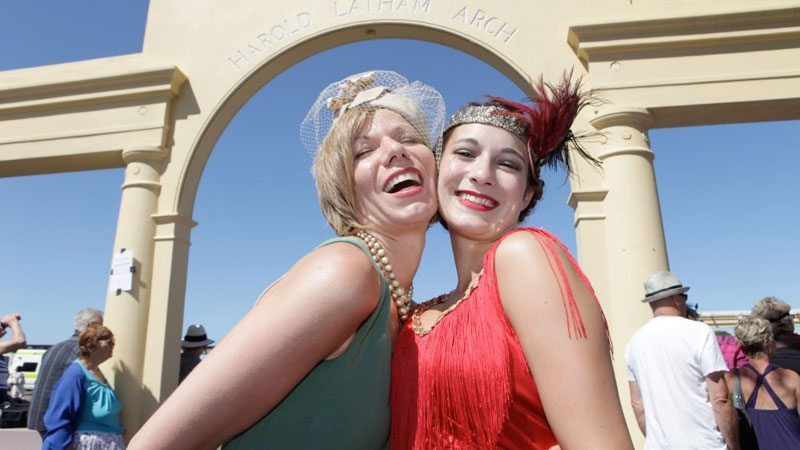Sadly missed by many international travellers, Napier is a wonderful place to visit – so great in fact that Napier should be avoided during New Zealand’s holiday periods due to the throngs of kiwi visitors drawn to the city and it’s surrounding area! Bathing in a Mediterranean climate and nestled idyllically on a superb coastal position Napier is the heart of one of the country’s premier wine-producing regions – the Hawkes Bay.
But what makes this town so unique? It’s friendly population, excellent restaurants, outstanding gardens and the incredible atmosphere created by its architectural heritage. Napier and neighbouring towns were devastated by a major earthquake and fire in 1931 resulting in frantic reconstruction of the city in a period regarded as the peak of the Art Deco era. Internationally recognised as representing the most complete and significant group of Art Deco buildings in the world, the city promotes walks and scenic drives with guided tours and walking-tour leaflets. Fancy dress dinners and balls are held during the annual Art Deco weekend held in February attracting visitors from around the country and the globe.
The Daily Telegraph Building is one of the finest examples of Art Deco in the city, and with numerous restored buildings in a concentrated area the city’s streets provide a colourful spread of visual delights for all, even those least interested in architecture! Some of the most striking examples include the Municipal Theatre, the Desco Centre, the clock tower, the Soundshell, the Esprit Buildings to name a few. The majestic Masonic Hotel graces the corner of Tennyson Street and the beautiful Marine Parade, almost announcing your arrival into the 1930’s – you’ll find great coffee there too! Although many shop fronts have been modified, looking up to the second floor of the buildings in Emerson Street will allow you to see the fine Art Deco detail such as zigzags, lightning flashes, rising suns and geometric shapes. The neighbouring streets exhibit a fine collection of buildings, all different shapes, sizes and colours. Well-established antique and curio shops are scattered around the town centre ensuring that every walking tour is a treasure hunt for all to enjoy!
Reminiscent of an old English seaside resort, the Marine Parade is lined with large Norfolk pines and some exceptional wooden buildings that managed to survive the quake. Complete with pebble beach, (although too hazardous for swimming), the ‘Parade’ has a collection of amusements including mini-golf, swimming pools, roller blading rink, bumper boats and miniature racing cars. For less action, visit the famous statue ‘Pania of the Reef’ and the sunken gardens. Marineland is New Zealand’s only marine zoo and wildlife centre. It provides a temporary home to seals, dolphins and blue penguins that have been rescued from the wild requiring treatment and rehabilitation. Some of the older ‘residents’ still enjoy performing daily, entertaining visitors with exceptional agility and humorous tricks – kids love it! You may choose to feed and touch the dolphins, and even swim with them in the safety of the pool – what a wonderful opportunity! Further down the Parade, the Hawkes Bay Aquarium has sharks, crocodiles, piranha, turtles and other animals including the native tuatara. A highlight would be daily feeding time when divers swim with the sharks in the main tank.
Nearby, Hastings and Havelock North share the same architectural creativity and are both well worth visiting. Take in the Art Deco and Spanish Mission Buildings, gardens, wineries and village atmosphere both towns offer. Being the chardonnay capital, Hawkes Bay vineyards include names such as Brookfields, Mission, Esk Valley Estate, Vidal of Hawkes Bay, Ngatarawa Wines and Church Road. Many are open for lunch – tours depart daily or you may self-drive. Or, for a more romantic adventure, hire a bicycle and tour the picturesque plains in a relaxed European style!
And, as with every other key destination in this amazing country, you have a long list of thrill-seeking activities to choose from in and around Napier. There is great swimming and surfing on the beach north of the port, jet boating on the Ngaruroro River, white-water rafting, horse-trekking, fishing, windsurfing, kayaking, canoeing, para-sailing, water skiing, tandem skydiving and paragliding, tramping and so on! The Cape Kidnappers Gannet Colony provides a wonderful ‘at-one-with-nature’ experience, with a diverse range of ways to get there. One of the most exciting ways of getting to the Cape is by 4-wheel motor bikes, and if you choose to make your own way by foot remember to check the tides as you may end up taking a swim or staying the night!
The inland region provides some of the best tramping on the North Island. The Department of Conservation (DOC) produces a series of pamphlets with information on tracks through the untamed Kaweka and Ruahine ranges. To the north near Wairoa, the Urewera National Park is home to the Waikaremoana Track, (sea of rippling waters), one of New Zealand’s Great Walks around an amazing lake of the same name. Birds, trout, deer and other wildlife are plentiful in the park – take time to observe them by boat or on the walks, which vary from half an hour to several days. The main track is rated easy with five huts conveniently spaced along the route – but at peak times it is wise to carry a tent! Kayaking is also available, even a tramp-paddle option allows a little variety and a different perspective on the Lake and it’s glorious surrounds.
There are plenty of places to stay in Napier, although it may pay to make reservations ahead if your visit takes in a weekend. Youth hostels, backpackers, motels, hotels, bed and breakfasts and very good camping grounds abound. Dining out is a popular pastime given the relaxed nature of the city’s population – there is no shortage of trendy cafe’s and the variety in cuisine will ensure you will find exactly what you fancy after a hard day on your feet!


Leave A Comment